 |
||
|
||
| ||
24 bits: myth and realityAnother Creative's favourite is the "24-bit mode". Everyone knows that a 16-bit graphics mode is worse than 24(32)-bit. That a 16-bit CPU is loses to 32-bit. The marketing department plays upon user associations from other fields to attract him by simpler things like bit depth. However, if it's simple from the angle of graphics as human eye sees artefacts from halftone saturation, everything is more complex from the point of audio. The main reason is that the dynamic range of 16-bit sound is very close to ear's sensitivity threshold. And if you perform noise shaping and cut frequencies over 20kHz, the signal still being in the 16-bit range will subjectively sound as 18-bit. Considering there are no effective 24-bit audio DACs, it's clear why CD-DA and 16-bit audio are still in demand. However such explanation naturally can't satisfy the marketing department that needs to promote another "24-bit crystal clear sound" model. But here enters the common opinion that digital sound is step-like! Just look how nice it is: 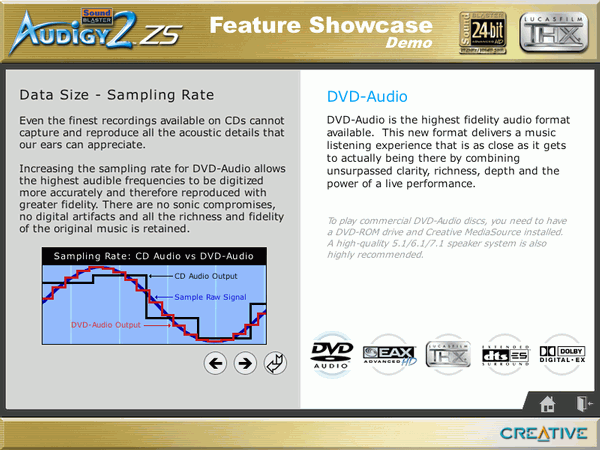
So where can you see the real pictures? For example, in CoolEdit. Instead of those dumb "jags" (like in SoundForge, for example), it draws both samples and interpolation filter. Let's take a 10kHz sinus (the steps you see are caused only by on-screen aliasing that we left not to slow the whole process down):  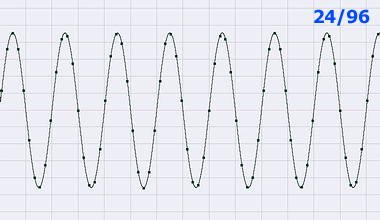 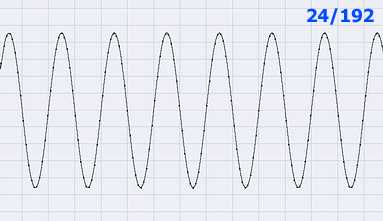 There is the difference, but it's not that impressive. Besides, it fully corresponds to acoustic sensation. Pity, but that's still evolution, not revolution. However, unlike 16/44, higher-end formats still have the potential that excites optimism. Besides, higher-resolution recordings provide better quality after compression at mixing and mastering. As least, the differences are audible even on good wooden case speaker systems like <$50 pc stereo speakers (for example, defender mercury 50). But let's get back to our cards. Is Audigy2 ZS capable of playing 24-bit sound in its real resolution?To answer this question, we must remember a way to control this. It's clear about the sampling rate, as it's seen on the gain-frequency characteristic. If the recalculation is used (like in Audigy1), this curve will drop abruptly after the half of recalc frequency is passed. We have a criterion for bit depth as well. The maximum recording dynamic range is approximately equal to 20 log (2^N), where N is the number of bits. Having measured DR and taken the inverse function, we can calculate the so-called "effective digit capacity". If it's recalculated into 16 bits somewhere, it will surely pare the final result down. DR (16-bit 44kHz within 20Hz — 20kHz) = 96.8dB = 97.8dBA DR (24-bit 96kHz within 20Hz — 48kHz) = 146.3dB = 151.0dBA As said above, there are still no DACs that use all the dynamic range. At the best the effective digit capacity is about 20 bits that stands for 120dB. Audigy2 ZS features CS4382 DAC with the following claimed specifications: 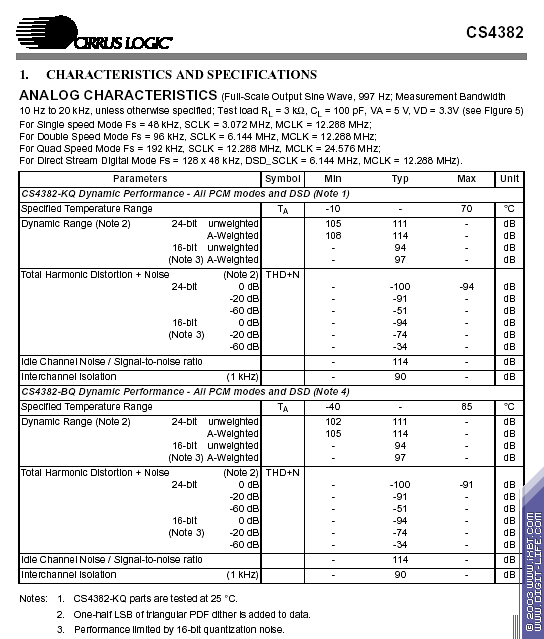 Note the comment that 16-bit DR is limited by 16-bit quantization noise. It's also indicative that 24-bit DR is 108-114 dBA. Note that these measurements were conducted within 10Hz — 20kHz at 25°C. As you know, PC chips heat up to 40-50°C that increases semiconductors' own thermal noise. By the way, SNR or "pause noise" is 114dB here, but this actually has no interest for anyone, I guess. Thus we can elaborate a criterion, so if results exceeds 16-bit theoretical limit, 24 bits are used somehow. The best card of all we tested — Lynx Two — with top-end DACs from the same maker, has 115dBA dynamic range in RMAA (APS2 shows 117dBA). 24-bit cards on Envy24HT show different results lying mostly within 100-106dBA that really seems to be true. Let's select the 48kHz mode most comfortable for the card, where there are no oversampling, and measure only the bit depth — 16 and 24 bits. We'll conduct measurements by Lynx Two with 117dBA input DR. The 20-20 filter will be disabled.
As you can see on spectrograms and in the results window, the 24-bit signal doesn't achieve parameters of 16-bit signal. Hypothetically, the reason might be some deep device mating specifics. Well! Let's do the same for card's digital S/PDIF output:
Pity, but we see the same picture. Though now we know the reason is card's digital part, i.e. DSP algorithms. This gives us hope they can be neutralized in the future drivers. To check if the program provides adequate results, we've conducted the same test on our reference card. As you can see, it works correctly within the truncation error.
Switched to the 24/96 mode, it produced the really surprising results:
This excites hope that this problem still can be solved by software. Besides, this card might have been measured with some special drivers. Anyway, this doesn't change the result. And we can't speak of full 24-bit support regarding Audigy2 ZS. Something strange resembling 16 bits is processed even through the digital path. To check if the destination card works correct, we conducted the same test on the digital output of M-Audio Revolution 7.1: Besides, the playback of the demo 24/96 DVD-Audio in WinDVD 5 (we've actually played the image from HDD to avoid DVD mechanical noise) on Audigy2 ZS and Revolution 7.1 using Event 20/20 monitors left me with a subjective feeling that Audigy2 provides fewer details. 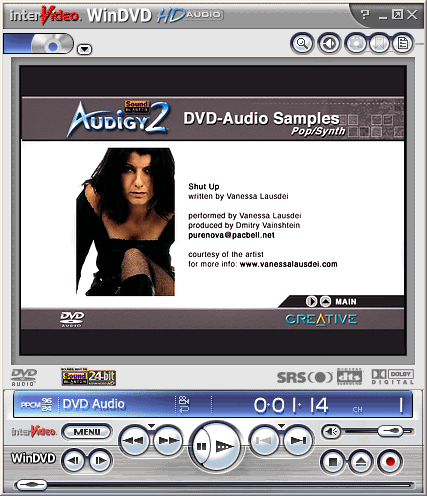 Pity, but we couldn't listen to Lynx Two, as WinDVD could only reboot the testbed with it. Write a comment below. No registration needed!
|
Platform · Video · Multimedia · Mobile · Other || About us & Privacy policy · Twitter · Facebook Copyright © Byrds Research & Publishing, Ltd., 1997–2011. All rights reserved. |